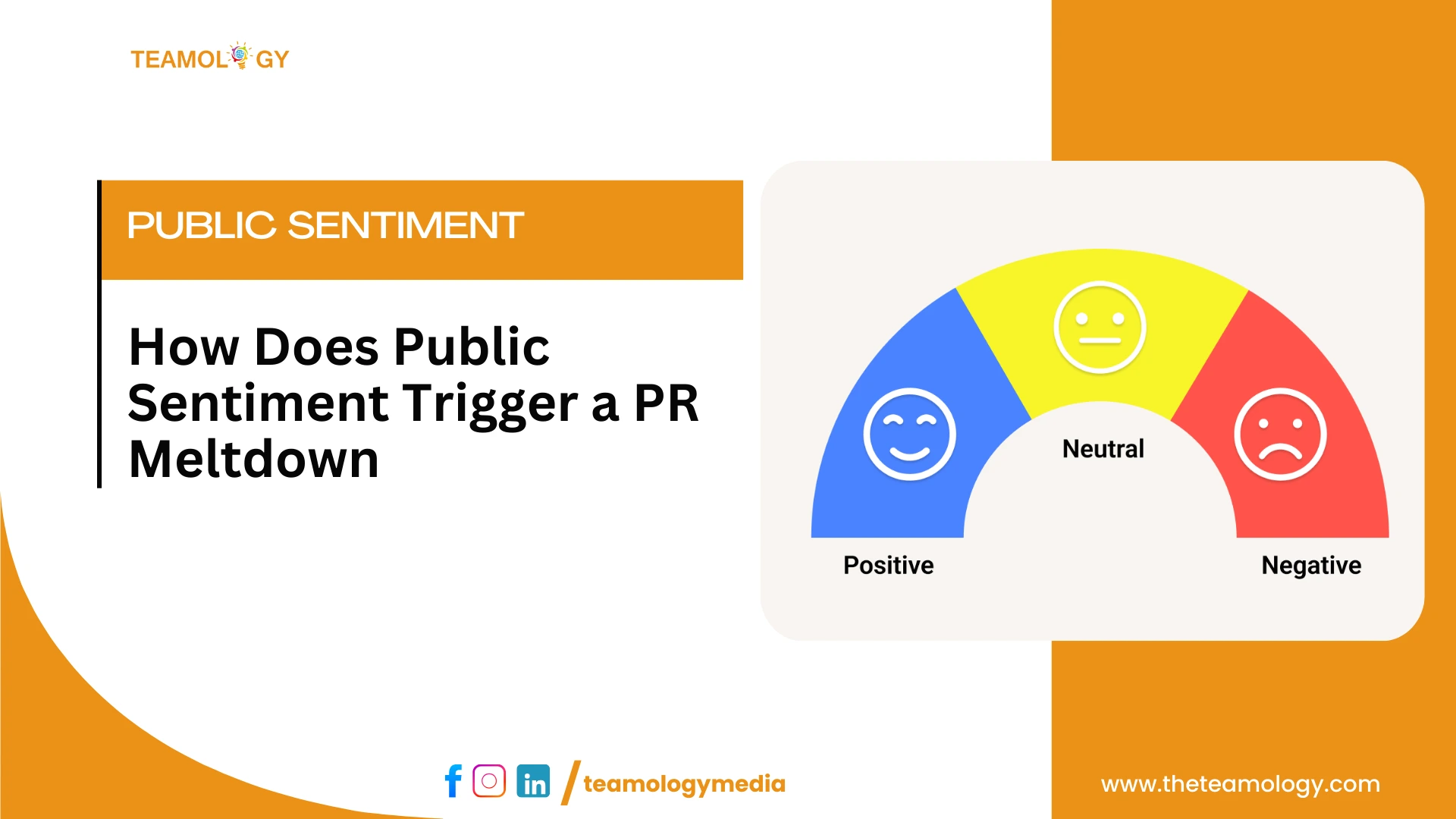A small mistaken post, a viral tweet from a distressed customer, or careless behavior by a staff member—these are often enough to throw a brand into crisis overnight.
In the digital age, public sentiment and PR crises are deeply intertwined.
In this blog, we’ll explain in simple terms how public sentiment can trigger PR meltdowns, explore a few case studies, and offer some practical solutions to help readers effectively handle PR crises.
Why is Public Sentiment so powerful?
When people react emotionally to an event—through outrage, fear, anger, or support – that response quickly spreads to others. Social media algorithms and news outlets amplify these emotions almost instantly.
The result? If negative feelings escalate, they can rapidly spiral into a full-blown PR meltdown.
In short, when public sentiment turns negative, the impact on PR disasters is swift, leading to business losses and a serious blow to brand trust.
How Public Sentiment Triggers PR Meltdown?
1. Trigger:
Product issues, tone-deaf ads, staff complaints, or a misguided influencer partnership.
2. Sharing & Amplification:
Once the first tweet or review goes viral, algorithms boost its reach exponentially.
3. Narrative Consolidation:
The same story starts circulating across platforms—people begin to accept it as the truth.
4. Stakeholder Response:
Customer boycotts, retailer pull-outs, and regulatory investigations – all combine to create a full-blown crisis PR scenario.
5. Timing Is Critical:
In this entire process, time is the biggest factor – a delayed response only worsens the damage.
Case Studies: Real-World Public Opinion Impact on PR Disasters
1) Maggi (2015) — Product Safety, Swift Recall & Recovery
Timeline Highlights:
- April–May 2015: Food regulators in several Indian states raise concerns about lead and MSG levels in Maggi noodles.
- June 2015: Multiple states pull Maggi from shelves; Nestlé halts sales and announces a nationwide recall.
- November 2015: After testing, transparent reporting, and regulatory approval, Maggi returns to the market.
Public Sentiment & Media Reaction:
- Consumer panic spreads instantly after initial reports.
- Negative social media buzz, alarming headlines, and retailer actions create a “panic wave.”
- Studies show an immediate drop in consumer behavior and long-term trust issues.
Brand Response (Crisis PR):
- Nestlé recalls all variants, conducts lab tests, coordinates with regulators, and publishes transparent reports before re-launch.
- Focused communication and trust-rebuilding campaigns follow.
Outcome:
- Initial financial loss and market share hit.
- Gradual recovery as transparency and regulator-backed testing rebuild trust.
- Research shows: In food safety crises, speed + transparency + credible evidence are key to recovery.
Key Learnings:
- Educate retailers/distributors in advance.
- Rapid Response Checklist (for Maggi-style issues):
- Public statement within 3–6 hours.
- Immediate lab testing and result sharing.
- Recall/halt announcement and retailer notification.
2) Cadbury (2003) — ‘Worms in Chocolate’ & Project Vishwas
Timeline & Trigger:
- October 2003: Reports of worms in Cadbury Dairy Milk surface; media coverage explodes.
- State FDA investigates; media framing and consumer backlash follow.
Public Sentiment & Media:
- Reports during the festive season (e.g., Diwali) cause rapid trust decline.
- Some reports suggest sales dropped by nearly 30%.
- Media tone was aggressive; consumers questioned packaging safety.
Cadbury’s Crisis PR & Operational Moves:
- Launches Project Vishwas:
- Introduces dual-layer “purity-seal” packaging.
- Trains retailers.
- Sets up media communication desks.
- Runs trust-rebuilding campaigns with celebrities and brand ambassadors.
- Cadbury claimed storage-level issues but still strengthened packaging and supply discipline.
Outcome:
- Cadbury gradually regains trust and market share through operational changes and public-facing communication.
Key Learnings:
- Words aren’t enough; visible operational changes matter more.
- Retailer storage and supply chain audits are crucial.
- Rapid Response Checklist (for chocolate/packaging issues):
- Immediate contact with retailers/suppliers.
- Fact-check and publish packaging/storage updates.
- Announce new packaging or retailer education if needed.
Preventing PR Crisis from Negative Sentiment — Practical Steps
1. Pre-launch Cultural Audit
Before launching an ad, campaign, or product, show it to people from diverse backgrounds to identify potential cultural sensitivities.
2. 24/7 Sentiment Monitoring
Set alerts — if mentions increase and sentiment decreases, automatically inform the PR team so they can address potential issues early, applying PR crisis management and public sentiment strategies to spot the warning signs of PR meltdown before it escalates.
3. Clear Crisis PR Playbook
Define who will speak, what they’ll say, and whom to involve – everything should be scripted and pre-approved.
4. First 48-Hour Response Template
Issue an immediate empathetic message, activate an investigation team, and open customer communication channels.
Final Words — Don’t overlook public sentiment, see it as support
In this hyper-digital era, understanding how public sentiment causes PR meltdowns helps you mitigate risks. If the sentiment turns negative, respond swiftly, transparently, and with empathy; present technical evidence; and rebuild long-term trust. Remember—making mistakes is normal, how you handle them is what truly defines your brand’s identity.
If your brand has faced such an incident and you feel overwhelmed by the situation, consider consulting our specialised PR experts. Contact us now and let’s work together to overcome your PR crisis and reestablish your brand’s reputation.


